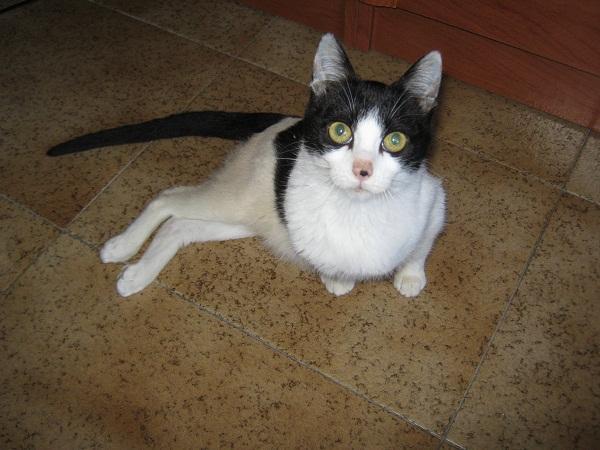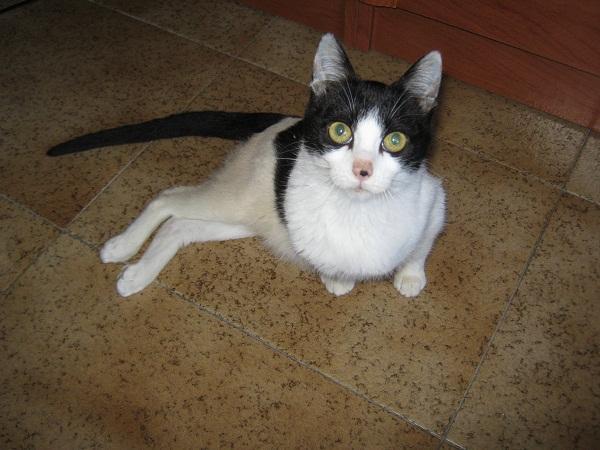
Our cats have a body which allows them to make various movements. An impressive ability is to move through small spaces which seem to be much smaller than their body should allow. They are able to do this, in part, due to a relatively supple spine. This spine also supports their skeletal structure and contains the spinal cord, the latter being essential for the central nervous system to function. For these reasons, if the cat has any type of spinal injury or problem, it can affect much more than their back.
At AnimalWised, we look at the various types of cat spine problems. We see how these can originate, as well as what treatment options may be available.
A cat's spine
The vertebral column, also known as the backbone or the spine, is part of a cat's skeleton. It is made of individual vertebrae which extend from the neck to the base of the tail. It is the key structure which supports the rest of the musculoskeletal system, allowing cats to move. The spine is essential in the cat being able to maintain stability, helping us to see why cats always land on their feet.
Most cats have 7 cervical vertebrae (neck vertebrae), 13 thoracic vertebrae, 7 lumbar vertebrae and about 22 caudal vertebrae. The caudal vertebrae are the parts which make up the tail bone. Not all cats will have this many, since there are certain tailless cat breeds.
Together, the individual vertebrae form a hyper-flexible spine which is more flexible than most other animals. This is also, in part, due to flexible intervertebral discs which prevent the vertebrae from breaking against each other. Their scapulae (shoulder blades) are not attached to the thoracic limbs. This gives them great agility and allows them to compress their size and enter small passages.
Thanks to their spine and the rest of their musculoskeletal structure, cats are flexible, light, athletic and strong. However, they are not indestructible. Their spine can suffer injury, as well as be vulnerable to various disorders. The consequences of these problems can seriously impede their well-being. Below we explain what are the most common spine problems in cats.
Osteoarthritis
Osteoarthritis is a chronic and degenerative disease that especially affects older cats. This is either due to a genetic predisposition or due to general wear and tear of the body which comes with age. There are other factors, such as obesity which can promote the deterioration of joints.
Specifically, osteoarthritis is a degeneration of cartilage, joint capsule and the bone around the affected joint. One of the most frequent locations of osteoarthritis in cars is in the lumbar region of the spine. This is one the main causes of lower back pain in cats. The feline is unable to move, climb and jump as they had previously due to the pain and discomfort these actions cause.
Despite being a relatively common disorder, it is too often underdiagnosed in older cats. This means the cats often live with severe pain in their later years.
For another common disorder which affects a cat's mobility, take a look at our article on hip dysplasia in cats.

Vertebral infection
Vertebral infection, specifically of the intervertebral discs, is called discospondylitis. Vertebral discs act as cartilaginous shock absorbers, preventing the vertebrae from rubbing against each other. It is a rare spinal problem in cats, but it should not be ignored due to the pain and potential immobilization it can cause.
When pathogens, mainly bacteria, reach these discs, they cause infection and inflammation. The consequence are clinical signs such as:
- Spinal pain
- Fibrous tissue proliferation
- Subluxations or vertebral fractures
- Compression of the spinal cord
Compression of the spinal cord can lead to paresis, changes in gait, ataxia and even paralysis. The primary source of infection by which microorganisms reach the spine are through the mouth, skin, respiratory system, genitourinary tract and the heart valves.
Vertebral fractures
Vertebral fractures can occur for various reasons. IN cats, it is common for them to suffer trauma to the spine due to falls. Cats like being up high and can develop high-rise syndrome, a process whereby cats choose to go up to a very high place and then fall from it. Cats can also receive spine trauma due to fights with other cats, road collisions and any situations which results in force trauma.
Fractures and trauma can cause spinal problems, secondary infections, damage to the sift tissue in the vertebrae and more. The extent of the damage determines the extent of the symptoms. In the worst case scenario, they will have to undergo surgery. The animal may show neurological signs, such as reduced or absent spinal reflexes and a deficit of proprioception, as well as severe pain.
It is possible they will have short acute pain, but irreparable damage can occur resulting in paralysis.

Spinal tumors
The vertebrae can also be affected by the development of tumors. In cats the most frequent are:
- Lymphosarcoma: this is a tumor of lymphocytes and mesenchymal cells that affect the vertebral bodies, especially in cats under five years of age with feline leukemia. Instead of breaking the vertebrae, this tumor usually forms an epidural mass that may be infiltrative.
- Osteosarcoma: it is the most common vertebral tumor in cats. It is a primary tumor that is usually diagnosed in elderly cats. It is normally very aggressive, causing periosteal reaction and metastasis to other organs, especially the lungs.
In addition, tumors can cause associated neurological signs if the spinal cord is affected.
Herniated disc
A herniated disc occurs when the intervertebral disc is dislocated and compresses the bone marrow. Most herniated discs in cats are asymptomatic. When the animal does present symptoms, these are due to disc protrusions of the discs located between the L5-L6, L6-L7 and L7-sacral vertebrae. If neurological signs are detected due to spinal involvement, it usually means it is a spine injury which can be treated via surgical intervention.
Vertebral angiomatosis
Vertebral angiomatosis is a rare malformation in which many angiomas (benign endothelial tumors) form. These non-cancerous masses create larger blood vessels. Although it is a benign process, it can produce neurological signs if it affects the spinal segments of the area.
Taking an X-ray it is possible to visualize bone proliferation phenomena. Treatment, if necessary, consists of surgical decompression.

Hyperesthesia syndrome
Feline hyperesthesia consists of an abnormally increased sensitivity of the skin. It is another uncommon disease. When it does occur, it usually does so in cats which have undergone a lot of stress. It is not a serious disease, much less lethal, but it has no treatment.
Its origin can be due to alterations of the cerebral electrical activity that control various normal behaviors of the feline. Affected cats develop muscle injuries in the spine that can contribute to discomfort. The clinical signs include:
- Excessive sensitivity to petting
- Muscle spasms on the back
- Self-harm
- Racing and jumping
- Dilated pupils
- Chasing tail
- Convulsions
If you think your cat might have suffered from a spinal injury, look for signs of pain in the cat. If they have any abnormal behavior, take them to a veterinarian for a checkup and potential diagnosis.
This article is purely informative. AnimalWised does not have the authority to prescribe any veterinary treatment or create a diagnosis. We invite you to take your pet to the veterinarian if they are suffering from any condition or pain.
If you want to read similar articles to Types of Cat Spine Problems, we recommend you visit our Other health problems category.
Harvey, A., & Tasker, S. (eds). (2014). Feline Medicine Manual. Ed. Sastre Molina, SL L ́Hospitalet de Llobregat, Barcelona.
Martín, P. An approach to discoespondylitis. Available at: https://www.imveterinaria.es/uploads/2018/06/aproximacion_discoespondilitis_1840_20180621110928.pdf
Martínez, A., Mateo, I., &Pumarola, M. Vertebral angiomatosis in a cat. Available at: https://www.clinvetpeqanim.com/img/pdf/1075356455.pdf